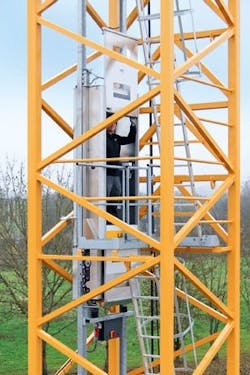I’m not from Missouri but I do like to be shown things.
That’s why I was intrigued by the 2015 Intermat Innovation Awards, presented during a “pre-Intermat” press event in Paris last week. The Gold winners in the “Construction Equipment” and “Equipment & Components” categories were some familiar names.
Wacker Neuson won for its 803 Dual Power compact excavator (already a Construction Equipment Top 100 Products of 2014 winner) that can run on diesel or electric power, and Liebherr for its LiUP crane operator elevator, which is a system that can operate inside or outside the tower section, and can be powered by a lithium ion battery with an energy-recovery system.
These are tangible, visible, touchable benefits. No suspension of disbelief asked for. No “You can’t see it, but trust us, you’ll find out later.”
It might be the beginning of a new age. Talking to OEMs in The City of Light, you could almost sense the relief that the heavy lifting on Tier 4 is behind them and they were free to concentrate on new ideas to improve iron. They were proud to point out machines, features and systems that were nominated for, or won, these awards.
It makes me wonder how much innovation has been lost or substantially delayed by committing years of massive R&D spending and millions of man-hours toward meeting the tiered/staged emissions regulations.
Has the alphabet soup of EGR, SCR, DEF, DOCs, and DPFs denied us the widespread dawn of autonomous machinery? Has it slowed the implementation of telematics, or the easier back-office integration of these systems? Would there be more alternative-fueled equipment choices? Perhaps advances in manufacturing that would lower machinery prices? (Okay, I’ve gone off the common rails and made that one up.)
There’s something much more satisfying about innovation you can actually see and touch versus innovation that someone tells you occurs unseen. The only evidence of the latter is often the money you’re told you’re not spending.
Trouble is, not everyone is wired that way. Rather, many of you dear readers say, “Show me what I am getting for what I’m spending.”
This is the fight manufacturers face in convincing end-users that the premium paid for Tier 4-Final machines is worth it—usually by touting the percentages of fuel efficiency increases over the previous generation of equipment. (We’ll take a look at how OEMs define their terms and numbers in our March issue.)
It’s a tough point to win.
About the Author
Frank Raczon
Raczon’s writing career spans nearly 25 years, including magazine publishing and public relations work with some of the industry’s major equipment manufacturers. He has won numerous awards in his career, including nods from the Construction Writers Association, the Association of Equipment Manufacturers, and BtoB magazine. He is responsible for the magazine's Buying Files.

